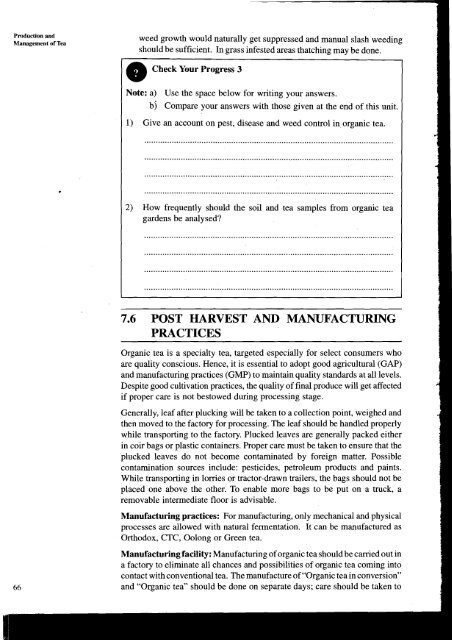UNIT 7 ORGANIC TEA - Vegetableipmasia.org
UNIT 7 ORGANIC TEA - Vegetableipmasia.org
UNIT 7 ORGANIC TEA - Vegetableipmasia.org
You also want an ePaper? Increase the reach of your titles
YUMPU automatically turns print PDFs into web optimized ePapers that Google loves.
Production and<br />
Management of Tea<br />
weed growth would naturally get suppressed and manual slash weeding<br />
should be sufficient. In grass infested areas thatching may be done.<br />
@ Check Your Progress 3<br />
Note: a) Use the space below for writing your answers.<br />
bj Compare your answers with those given at the end of this unit.<br />
1) Give an account on pest, disease and weed control in <strong>org</strong>anic tea.<br />
.............................................................................................................<br />
.............................................................................................................<br />
.............................................................................................................<br />
.............................................................................................................<br />
2) How frequently should the soil and tea samples from <strong>org</strong>anic tea<br />
gardens be analysed?<br />
.............................................................................................................<br />
.............................................................................................................<br />
.............................................................................................................<br />
.............................................................................................................<br />
POST HARVEST AND<br />
PRACTICES<br />
MANUFACTURING<br />
Organic tea is a specialty tea, targeted especially for select consumers who<br />
are quality conscious. Hence, it is essential to adopt good agricultural (GAP)<br />
and manufacturing practices (GMP) to maintain quality standards at all levels.<br />
Despite good cultivation practices, the quality of final produce will get affected<br />
if proper care is not bestowed during processing stage.<br />
Generally, leaf after plucking will be taken to a collection point, weighed and<br />
then moved to the factory for processing. The leaf should be handled properly<br />
while transporting to the factory. Plucked leaves are generally packed either<br />
in coir bags or plastic containers. Proper care must be taken to ensure that the<br />
plucked leaves do not become contaminated by foreign matter. Possible<br />
contamination sources include: pesticides, petroleum products and paints.<br />
While transporting in lorries or tractor-drawn trailers, the bags should not be<br />
placed one above the other. To enable more bags to be put on a truck, a<br />
removable intermediate floor is advisable.<br />
Manufacturing practices: For manufacturing, only mechanical and physical<br />
processes are allowed with natural fermentation. It can be manufactured as<br />
Orthodox, CTC, Oolong or Green tea.<br />
Manufacturing facility: Manufacturing of <strong>org</strong>anic tea should be carried out in<br />
a factory to eliminate all chances and possibilities of <strong>org</strong>anic tea coming into<br />
contact with conventional tea. The manufacture of "Organic tea in conversion"<br />
and "Organic tea" should be done on separate days; care should be taken to




![Section 4 [ PDF file, 252 KB] - The Field Alliance](https://img.yumpu.com/51387260/1/158x260/section-4-pdf-file-252-kb-the-field-alliance.jpg?quality=85)












